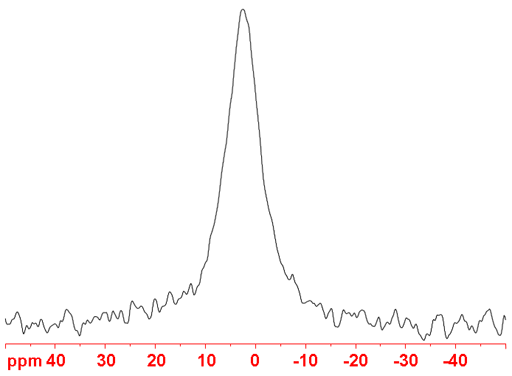(87Sr) Strontium NMR
Use our NMR service that provides 87Sr NMR and many other NMR techniques.
87Strontium (87Sr) is a low sensitivity nucleus that yields broad lines (fig. 1) in even in symmetric environments over a small chemical shift range. 87Sr is a spin 9/2 nucleus and is therefore quadrupolar. As a result, the signal width increases with asymmetry of the environment. There is very little published work on high-resolution 87Sr NMR and its main use is likely to be measurement of strontium binding using its relaxation properties. There is little information available about chemical shifts (fig. 2).
Fig. 1. 87Sr-NMR spectrum of SrCl2 (1M) in D2O

Fig. 2. Chemical shift ranges for strontium NMR

Properties of 87Sr
| Property | Value |
|---|---|
| Spin | 9/2 |
| Natural abundance | 7.00% |
| Chemical shift range | 61 ppm, from -23 to 38 |
| Frequency ratio (Ξ) | 4.333882% |
| Reference compound | 0.5 M SrCl2 in D2O |
| Linewidth of reference | 106 Hz |
| T1 of reference | 0.0032 s |
| Receptivity rel. to 1H at natural abundance | 1.90 × 10-4 |
| Receptivity rel. to 1H when enriched | 2.71 × 10-3 |
| Receptivity rel. to 13C at natural abundance | 1.12 |
| Receptivity rel. to 13C when enriched | 16.0 |
| Linewidth parameter | 83 fm4 |
Safety note
Some of the materials mentioned here are very dangerous. Ask a qualified chemist for advice before handling them. Qualified chemists should check the relevant safety literature before handling or giving advice about unfamiliar substances. NMR solvents are toxic and most are flammable. Specifically, strontium salts are toxic in very large doses besides any toxicity that may arise from the anion: wear gloves.
References
- J. Banck and A. Schwenk, "Strontium-87 NMR studies", Z. Phys., 265, 165-71 (1973).